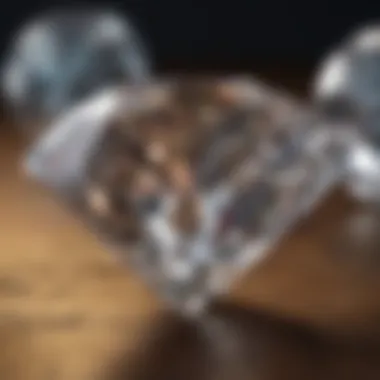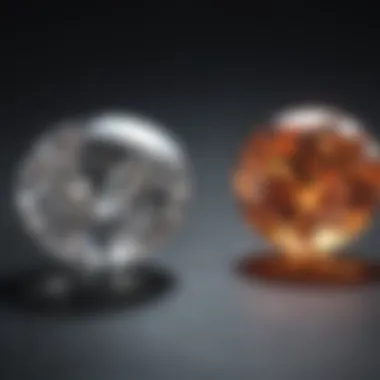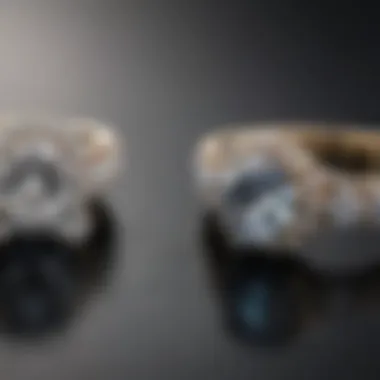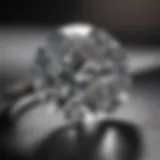Understanding the Diamond Clarity Rating Scale


Intro
The domain of gemstones speaks to both the geological marvels and the deeply ingrained cultural symbolism that has evolved over centuries. Among gemstones, diamonds occupy a unique position largely due to their exceptional hardness and beauty. However, not all diamonds are created equal; this is where clarity comes into play. When consumers search for diamonds, they are often met with a confusion surrounding the clarity rating scale, which is essential for making informed decisions.
The clarity rating scale evaluates the internal and external characteristics of diamonds, providing a structured way to assess quality. Through understanding this scale, one can appreciate the intricate factors that contribute to a diamond's overall appearance and, consequently, its market value. In this article, we will explore the key elements of the diamond clarity rating scale, the grading processes that underpin it, and its ramifications in the jewelry market.
Overview of Gemstones and Minerals
History of Gemstone and Mineral Use
Throughout history, gemstones have captured human fascination due to their beauty and rarity. Ancient civilizations utilized gemstones not only as adornments but also for symbolic and medicinal purposes. For instance, the Ancient Egyptians revered lapis lazuli, often associating it with the heavens and spirituality. In contrast, diamonds have historically symbolized power and status, often reserved for royalty and the elite. Their significance continues into modern times, where diamonds are not only viewed as luxury items but are also treasures that celebrate love and commitment.
Significance in Culture and Society
Gemstones are ingrained in various cultural practices and rituals. In some cultures, gemstones are believed to possess protective properties or to enhance certain traits in individuals. For example, the birthstone tradition encourages individuals to wear their respective gemstones associated with their birth month for good fortune. Consequently, understanding the various qualities of gemstones, including clarity, becomes imperative for collectors, designers, and consumers alike.
Gemstone Formation and Properties
Formation Process of Gemstones
Gemstones, including diamonds, originate from the earth’s crust through geological processes over millions of years. Diamonds are formed under extreme heat and pressure, primarily deep within the Earth's mantle. These natural processes result in unique properties that define each gemstone.
Properties that Define Gemstones
The key properties that classify gemstones include
- Hardness
- Luster
- Color
- Clarity
These features help determine not only how a gemstone looks but also its durability and suitability for various types of jewelry.
Classification based on Color, Hardness, and Luster
While diamonds are typically classified based on clarity, it is important to note how color and other properties contribute to their overall quality. Diamonds come in various colors, from colorless to shades of yellow or even blue and red. Each color affects how it appears under different lighting, further complicating its classification. Durability is often linked to hardness, which is measured on the Mohs scale, where diamonds rank at the very top.
Types of Gemstones
Precious vs. Semi-Precious Gemstones
Gemstones are categorized into two primary types: precious and semi-precious. Precious gemstones include diamonds, rubies, sapphires, and emeralds. These are generally more valuable due to their rarity and the complexity of their formation. Semi-precious gemstones, such as amethyst and aquamarine, are more abundant but can still hold significant aesthetic and commercial value.
Common Gemstone Varieties
The world of gemstones is vast, featuring numerous varieties that appeal to different tastes and preferences. Beyond diamonds, notable mentions include:
- Emeralds
- Rubies
- Sapphires
- Topaz
Exotic and Rare Gemstones
Some gemstones are exceptionally rare and sought after in the market. These include:
- Taaffeite
- Painite
- Red beryl
Understanding these gemstones can enhance one’s appreciation for diversity within the market.
Identifying and Evaluating Gemstones
Factors Affecting Gemstone Value
Several factors influence gemstone valuations. Among them, rarity, size, color, and clarity play pivotal roles. For diamonds, clarity is particularly critical as it can significantly affect both the visual and monetary value of the stone.
Techniques for Gemstone Identification
To determine the authenticity and quality of gemstones, various techniques are utilized:
- Magnification for clarity assessment
- Refractometers for measuring light refraction
- Spectroscopes for evaluating color and quality
Assessing Gemstone Quality
Evaluating gemstone quality involves a comprehensive examination of its physical characteristics. Tools of the trade, including loupes and microscopes, enable gemologists to identify inclusions and blemishes that impact clarity ratings.
Caring for Gemstones
Cleaning and Storing Gemstones Properly


Proper care and maintenance extend the longevity of gemstones. Simple cleaning can often be done using mild soaps and warm water. Storing gemstones in soft cloths or padded containers prevents scratches and damage.
Avoiding Common Mistakes in Gemstone Care
It is crucial to eliminate practices that can harm gemstones, such as using harsh chemicals or exposing them to extreme temperatures.
Preservation Tips for Specific Gem Types
Different gemstones may require unique care strategies. For example, softer stones like opals demand gentler handling, while diamonds can withstand harsher conditions due to their hardness.
By delving into the specifics of clarity, we lay the groundwork for understanding how diamonds are valued in the marketplace, affecting purchasing decisions and ultimately influencing the jewelry industry as a whole.
Prologue to Diamond Clarity
The concept of diamond clarity is crucial in the world of gemstones, particularly for those seeking to understand the beauty and quality of diamonds. Clarity refers to the absence of inclusions and blemishes within a diamond. This evaluation is a key factor that influences both the aesthetic appeal and market value of a diamond. As such, a comprehensive understanding of clarity helps buyers make informed choices when selecting their gemstones.
Definition of Clarity
Clarity in diamonds is defined as the measure of how clear a diamond is, based on the presence of internal and external flaws. Internal flaws are known as inclusions, while external flaws are termed blemishes. They can impact the stone's visual appeal and its ability to reflect light effectively. Diamonds are graded on a scale that ranges from Flawless (FL), indicating no visible blemishes or inclusions, to Included (I1, I2, I3), which signifies the presence of noticeable flaws. Each clarity grade reflects the diamond's rarity and plays a significant role in its valuation.
Importance of Clarity in Diamonds
Understanding the clarity of diamonds is essential for several reasons:
- Aesthetic Quality: Higher clarity grades generally result in a more brilliant and beautiful diamond. This is because light can pass through the stone more freely, enhancing its sparkle.
- Value Assessment: Clarity is one of the key factors in determining a diamond's price. Stones that have fewer imperfections tend to command higher prices in the market.
- Purchasing Decisions: For consumers, clarity is a critical aspect when choosing a diamond for jewelry. Knowledge about clarity helps buyers decide the trade-offs they may want to make with other factors such as carat weight or color.
"The clarity of a diamond can significantly affect its overall appearance, making it a vital consideration for any buyer."
By remaining informed about diamond clarity, buyers can better navigate their options, ensuring they choose a piece that aligns with both their personal taste and financial considerations.
Overview of the Clarity Scale
The clarity scale is a pivotal concept in the evaluation of diamonds. It provides a structured way to identify and categorize the presence of internal and external characteristics that may affect the visual appeal and monetary value of a gemstone. Understanding this scale is crucial not only for buyers but also for industry professionals. It helps in establishing common ground in assessing diamond quality.
The clarity scale plays an important role in the diamond market. Without this standardized system, the communication between jewelers and customers would be convoluted. Every stone can tell a story through its clarity. A diamond with higher clarity grades is likely to be more valuable, influencing consumers’ purchasing decisions significantly.
Understanding Clarity Grades
The clarity grades serve as a foundation for distinguishing the level of inclusions and blemishes in diamonds. Each grade indicates how visible these imperfections are at 10x magnification, a standard measure used in the industry. The GIA and similar organizations have established a clear grading scale:
- Flawless (FL): No inclusions or blemishes visible.
- Internally Flawless (IF): No internal inclusions; only surface blemishes may be present.
- Very Very Slightly Included (VVS1 and VVS2): Inclusions are very difficult to see under magnification.
- Very Slightly Included (VS1 and VS2): Inclusions are minor and can be seen with some effort.
- Slightly Included (SI1 and SI2): Inclusions are noticeable and may affect transparency or brilliance.
- Included (I1, I2, and I3): Inclusions are obvious and may impact overall structural integrity.
Understanding these clarity grades allows buyers to make informed choices based on their preferences and budget constraints.
How Clarity is Measured
Measuring clarity involves a meticulous process. The examination is typically done using a microscope or a jewelers loupe. Here, professionals look for inclusions such as crystals, feathers, and clouds, as well as external blemishes like scratches and nicks. The skills of the gemologist play a critical role in this evaluation. Factors such as the size, quantity, and location of the inclusions relative to the overall gem affect its clarity grade.
In addition to visual assessment, light performance is also taken into account. A diamond's ability to reflect and refract light can exacerbate the appearance of imperfections, further influencing its clarity perception.
Ultimately, understanding clarity will empower jewelry professionals and consumers alike to appreciate the nuances that come with different grades, leading to better informed choices in every diamond purchase.
The GIA Clarity Grading System
The Gemological Institute of America (GIA) is a prominent organization in the field of gemology. It developed a clarity grading system that sets the standard for diamond evaluation globally. Understanding this system is essential as it brings clarity in determining quality and value of diamonds. The GIA's ratings are widely accepted in the industry, making them critical for both consumers and professionals.
Prolusion to GIA
The GIA was established in 1931 with a mission to protect the public by setting a standard for grading gemstones. Its rigorous grading system ensures diamonds are evaluated consistently and objectively. The GIA trains gemologists and provides detailed reports on gemstone features. This credibility helps consumers make informed choices when purchasing diamonds. The GIA’s clarity grading system specifically focuses on internal and external features that impact the visual appeal of a diamond.
GIA Clarity Scale Explained
The GIA Clarity Scale includes specific grades that provide insights into the quality of a diamond. Each grade reflects the presence and visibility of inclusions and blemishes. Below are the distinct clarity grades:
Flawless (FL)
Flawless diamonds are the pinnacle of clarity in the GIA grading system. No inclusions or blemishes are visible even under 10x magnification. This high standard makes Flawless diamonds very rare and highly sought after. Their perfect nature contributes significantly to their overall value. However, the limited availability means they can be substantially more expensive than lower clarity grades.
Internally Flawless (IF)
Internally Flawless diamonds have no internal flaws, but might show some minor surface blemishes. These diamonds exhibit exceptional brilliance and light performance. Their near-perfect nature makes them a popular choice among diamonds enthusiasts and collectors. The slight surface imperfections are often difficult to detect without magnification, making Internally Flawless stones both prestigious and valuable.
Very Very Slightly Included (VVS1 and VVS2)


Diamonds in this category have minute inclusions that are very difficult for skilled graders to see under 10x magnification. VVS1 includes stones with fewer or less noticeable inclusions than VVS2. These diamonds maintain a high level of clarity, allowing them to reflect light beautifully. They offer a good balance between quality and price, making them an attractive option for many buyers.
Very Slightly Included (VS1 and VS2)
Very Slightly Included diamonds contain minor inclusions that are visible under 10x magnification, yet generally not visible to the naked eye. VS1 diamonds have fewer inclusions when compared to VS2 diamonds. This gives them a good level of clarity with good value propositions. Buyers often choose these diamonds when looking for beauty at a more accessible price point.
Slightly Included (SI1 and SI2)
Slightly Included diamonds have noticeable inclusions that may be seen with the naked eye, particularly in SI2 stones. SI1 diamonds may still appear visually appealing, even if they have minor flaws. They represent a midpoint on the clarity scale, providing options for those who want a significant diamond without breaking the bank. However, buyers should be aware that visible inclusions may detract from the stone’s overall aesthetic.
Included (I1, I2, and I3)
Included diamonds have notable inclusions that are visible without magnification, impacting clarity and brilliance. I1 diamonds may appear somewhat appealing, but I2 and I3 stones often contain more significant flaws, leading to duller appearances. Buyers seeking these diamonds typically do so for budget-friendly reasons, knowing they may compromise on clarity. Yet, understanding these inclusions is necessary to assess the potential value.
Other Clarity Grading Systems
Diamond clarity evaluation systems vary beyond the widely recognized GIA standard. Understanding these alternative grading systems can provide additional insights for gemstone enthusiasts and collectors, helping them to gauge the quality of a diamond more comprehensively. The differences in grading criteria and interpretation can influence consumer choices and, subsequently, market trends. This section will explore the AGL and EGL grading systems and the broader comparative clarity standards in the diamond industry.
AGL and EGL Grading Systems
The American Gemological Laboratories (AGL) and the European Gemological Laboratory (EGL) offer platforms for diamond grading that, while similar to GIA, have notable differences.
AGL primarily focuses on colored gemstones but also provides clarity ratings for diamonds. Their clarity scale is somewhat parallel to GIA, yet they might assign a slightly different emphasis on specific inclusions and blemishes in their assessments. This can result in AGL diamonds having a unique position in the market due to their specialized approach.
The EGL, with its presence in both Europe and North America, has often been viewed as more lenient in its grading criteria when compared to GIA. This aspect might attract certain buyers seeking lower clarity grades at more accessible prices. It is important to note, however, that this can lead to discrepancies in perceived value.
In both cases, understanding the grading criteria and standards is fundamental for any consumer or investor. Watch for potential variations in clarity grades between GIA, AGL, and EGL. Each system has its nuances and implications for the valuation of diamonds, which can affect resale and purchase decisions.
Comparative Clarity Standards
When discussing clarity grading systems, comparative standards are essential for contextualizing a diamond's quality within the entire industry landscape. Various laboratories may utilize different techniques and criteria, such as:
- Inclusion Size: Some systems prioritize the size and visibility of inclusions more than others, impacting the grade.
- Blemish Interpretation: Different labs may classify the impact of surface blemishes differently, altering the final clarity assessment.
- Lighting Conditions: The conditions under which clarity is assessed can influence grading—some labs may evaluate under brighter or specialized lighting.
This variation in grading philosophy and practice results in diamonds being rated differently across systems, a factor every jewelry designer or collector must consider. The more understanding one has about these grading variabilities, the better equipped they will be in making informed purchasing decisions.
"Educated consumers can navigate the diamond market with greater assurance when they understand the intricacies of clarity grading systems."
Every grading system carries its methodology and biases, so an appreciation for these differences is crucial for a nuanced perspective on diamond quality. Understanding these grading systems can aid individuals in selecting diamonds that align with their specific needs and preferences.
Evaluating Diamond Clarity
Evaluating diamond clarity is essential for understanding the quality and value of a diamond. Clarity plays a significant role in determining a diamond's aesthetic appeal and market price. A diamond with fewer inclusions and blemishes is more valuable due to its rarity and brilliance. Evaluating clarity involves detailed examination and analysis, helping consumers make informed decisions when purchasing a diamond.
Role of Magnification in Clarity Assessment
Magnification is a critical tool in assessing diamond clarity. Often, inclusions and blemishes are microscopic and can only be detected under a jeweler's loupe or microscope. A magnification of 10x is standard, allowing an accurate evaluation of a diamond's clarity grade. This examination reveals internal features like feathers, crystals, and clouds, as well as external blemishes such as scratches and nicks.
This level of detail ensures that buyers understand the actual quality of the diamond they are considering.
"Understanding the clarity of a diamond requires careful inspection. A loupe can uncover flaws invisible to the naked eye."
By utilizing magnification, gemologists can accurately classify diamonds according to established clarity grading systems, such as the GIA scale. Understanding the role of magnification provides insight into why clarity is more than just a label; it is an informed judgment about a stone's true quality.
Tools Used for Clarity Grading
Various tools are employed to evaluate diamond clarity. Each contributes to a comprehensive assessment of the stone's characteristics:
- Jeweler's Loupe: This handheld magnifying glass is vital for inspecting diamonds. It allows examination of the diamond's surface and internal features.
- Microscope: A more sophisticated tool, the microscope offers enhanced magnification and lighting, providing a detailed view of inclusions and blemishes.
- Digital Imaging: Some gemologists use advanced imaging technology to create high-resolution images of diamonds. This helps in documenting clarity for reports.
- Refractometer: This instrument measures the refractive index of the diamond, aiding in authenticity checks and assessing clarity.
These tools are crucial for accurate clarity grading. They assist in determining a diamond's value based on its unique features and flaws. Understanding these tools equips consumers with knowledge about the evaluation process, ensuring that buying decisions are based on thorough analysis rather than aesthetics alone.
Impact of Clarity on Diamond Value
The clarity of a diamond significantly influences its overall value. This section examines how clarity impacts pricing, consumer perception, and the general market dynamics of diamonds. In the competitive world of gemstones, understanding clarity is crucial for both buyers and sellers.
Price Variations by Clarity Grade
The price of a diamond is largely determined by its clarity grade. Diamonds that are graded as Flawless or Internally Flawless demand a premium. These gems exhibit little to no internal or external blemishes. Conversely, diamonds with visible inclusions or blemishes, such as those graded as Included, are typically less expensive.
- Flawless (FL): These diamonds have no inclusions visible under 10x magnification. They are exceedingly rare and command the highest prices.
- Internally Flawless (IF): Like FL diamonds, they may have surface blemishes that are undetectable without magnification. Their value is also near the top end of the scale.
- Very Very Slightly Included (VVS1 and VVS2): Though they contain minor inclusions, they are difficult to see without strong magnification. Their prices are high, though slightly less than FL and IF diamonds.
- Other Grades: As clarity grades move down the scale, prices decrease accordingly. For instance, diamonds graded as Slightly Included or Included can vary considerably in price based on how visible their flaws are.
In summary, as the clarity grade decreases, the price of the diamond typically does as well. Factors such as market demand and trends can also affect these price variations.


Consumer Perception of Clarity
Consumer perception of diamond clarity plays a vital role in how diamonds are marketed and sold. Many buyers may not fully understand the nuances of the clarity grading scale. However, they often associate higher clarity with greater beauty and durability.
- Understanding Clarity Grades: Consumers tend to prefer diamonds that are graded as VVS or VS over those with lower grades. This preference is driven by the belief that higher clarity equates to a more beautiful and valuable gemstone.
- Aesthetics vs. Price: While clarity is important, not all consumers prioritize it above all else. Some might choose diamonds with slight inclusions that provide better value or fit within their budget. Nonetheless, a common trend shows that consumers are willing to invest in higher clarity diamonds for special occasions.
In essence, while the clarity rating affects the price, it also shapes consumer perceptions. High clarity can enhance desirability, leading to a higher marked price in the market. Education about clarity can empower consumers to make informed purchasing decisions based on their personal preferences and financial considerations.
Visual Characteristics of Clarity
Understanding the visual characteristics of diamond clarity is essential for anyone looking to evaluate these gemstones comprehensively. The clarity of a diamond directly affects not only its aesthetic qualities but also its value in the market. It is crucial to recognize that diamonds contain unique imperfections known as inclusions and blemishes. These characteristics can significantly influence the appearance and light performance of each stone.
Identifying Inclusions and Blemishes
Inclusions are internal flaws or irregularities within a diamond. They can take many forms, from tiny crystals to bubbles or clouds. On the other hand, blemishes are external imperfections, like scratches or nicks on a diamond's surface.
When assessing a diamond's clarity, jewelers often use magnification tools, such as a jeweler's loupe or microscope, to closely analyze these features. The presence, size, and location of inclusions and blemishes affect the clarity grade assigned to a diamond, which consequently impacts its beauty and value.
To effectively identify inclusions and blemishes, the following elements should be considered:
- Type of Inclusion: Recognizing the type can help assess severity.
- Location: Inclusions closer to the surface may be more visible.
- Size: Larger inclusions usually lead to lower clarity grades.
- Number of Flaws: Multiple inclusions can compound their visibility.
Determining these visual attributes allows buyers to make informed decisions about their purchases, ensuring they select diamonds that align with their preferences.
Clarity's Influence on Light Performance
Clarity is not just about the presence of inclusions but also about how these characteristics interact with light. Diamonds are renowned for their brilliance and fire, which refers to the dispersion of light into colors. The higher the clarity, the more light can pass through the diamond without interference.
Inclusions, particularly those that are large or near the surface, can obstruct light and reduce the overall sparkle of a diamond. This is crucial for consumers to comprehend. A low-clarity diamond might appear dull compared to a higher clarity one, which can capture and reflect light brilliantly. Thus, clarity plays a critical role in the diamond's visual appeal.
When selecting a diamond, consider:
- Clarity Grade: Higher grades typically display superior light performance.
- Type of Cuts: Some cuts optimize light return better than others.
- Personal Preference: Some may prefer certain inclusions as part of the diamond's character.
By understanding how clarity impacts light performance, consumers can appreciate the nuances that set each diamond apart.
Choosing the Right Clarity for Your Needs
Choosing the right clarity for your diamond is essential for making a well-informed purchase. Clarity affects not only the visual appeal of the diamond but also its value. A clear understanding of clarity ratings can guide consumers through the decision-making process. Understanding personal preferences and balancing clarity with other important factors are vital when selecting a diamond.
Understanding Personal Preferences
Personal preferences play a significant role in determining the desired clarity grade. Each individual may prioritize certain characteristics based on their unique tastes and the purpose of the diamond. For example, if the diamond is intended for daily wear, a customer might prefer a slightly included diamond that offers more durability and value. Conversely, for an engagement ring that is meant to be a showpiece, a higher clarity grade could be the priority.
Many people are drawn to clarity grades that align with their aesthetic choices. A Flawless (FL) or Internally Flawless (IF) diamond likely appeals to those seeking perfection. However, higher clarity often comes with a higher price tag. It is essential for buyers to communicate clearly their emotional and financial limits, as these elements influence how they perceive clarity in a diamond.
Balancing Clarity with Other Factors
Balancing clarity with other factors helps create an overall understanding of a diamond's quality. While clarity is important, other aspects like color, cut, and carat weight should be considered as well.
Color
Color in diamonds ranges from colorless to shades of yellow and brown. A colorless diamond is often considered more desirable. It allows for maximum light performance, enhancing brilliance and sparkle. Choosing a higher color grade can enhance the visual effect of clarity and makes the diamond appear more vibrant.
However, not every consumer prioritizes color as much. Some may prefer slightly tinted stones, especially if they are less expensive and still look appealing. An awareness of personal taste can help someone make an informed choice about what color complements their selected clarity.
Cut
The cut of the diamond refers to how well it has been shaped and faceted. A well-cut diamond will reflect light beautifully, enhancing its brilliance. A lower clarity grade can be mitigated by an excellent cut, making the diamond still appealing despite inclusions. For instance, a Slightly Included (SI1) diamond with an ideal cut can look more attractive than a Very Slightly Included (VS2) diamond with a poor cut.
The cut must, therefore, align with clarity choices. A brilliant cut maximizes the diamond's ability to dazzle, regardless of some minor flaws.
Carat Weight
Carat weight measures how much the diamond weighs. Consciously selecting the right carat weight, alongside clarity, can affect the overall appearance. Larger diamonds tend to show inclusions more easily, making clarity more crucial. Smaller diamonds, on the other hand, can have lower clarity without significant visual impact.
The relationship between carat weight and clarity is also tied to budget. A higher carat weight paired with a lower clarity rating can still provide a visually appealing result without exceeding budgets. The right balance reflects both personal preference and financial considerations.
Ultimately, understanding how these factors interconnect aids in achieving the ideal diamond outcome.
End
Key Takeaways on Diamond Clarity
- Clarity Levels Matter: Each grade affects the pricing and desirability of diamonds, especially for collectors and designers.
- Visual Characteristics: Recognizing inclusions and blemishes helps in assessing a diamond's clarity.
- Long-Term Value: Higher clarity grades often ensure a better return on investment, representing lasting allure and quality.
Final Thoughts on Making an Informed Decision
When buying a diamond, clarity is one of several critical factors. It must be evaluated in conjunction with cut, color, and carat weight to achieve a well-rounded purchase. Every consumer's needs are unique, so finding the right balance is essential. An informed decision considers personal preferences and overall value.
Understanding clarity grading not only enhances appreciation for diamonds, but also guides consumers toward fulfilling their aesthetic and financial aspirations.







